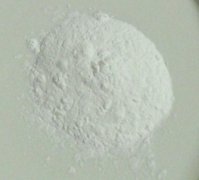Arrowroot Nutrition facts
Arrowroot is a starch-rich, creeping underground rhizome belonging to the Marantaceae family of plants. It is widely cultivated in the Philippines, Caribbean islands, and South America for its fine, easily digestible edible starchy tubers.
Some of the common names are West-Indian arrowroot, uraro (in the Philippines), arruruz, araru, cara maco, sagu, yuquill, etc.Scientific Name: Maranta arundinacea. Its powder is one of the finest carbohydrate sources. The powder is endowed with qualities such as easy digestibility, and the ability to mix well with a broad range of food ingredients; rating it as one of the most sought-after starch substances employed in infant formulas and confectionaries.

|
| Arrowroot powder. |
Arrowroot is native to South America; and probably originated in the lowlands of western Brazil. The plant is a small perennial herb, growing to the length of 3 to 5 feet with turmeric-like broad, flat, ovate-shaped leaves. Tiny, white flowers in pairs appear all along the long pedicle about 90 days after planting.
The root is actually an underground, small, cylindrical-shaped cream-white/light red tuber, covered with thin surface scales. The tubers can be ready for harvesting after about 10-12 months of planting. Each root weighs about 30 to 50 g.
Arrowroot is in general employed to obtain starch and may yield about 12-15% of starch by dry weight. Arrowroot powder is a fine, clear white, and odorless item, found used as a thickening agent in the food industries.
Health benefits of Arrowroot
Arrowroot is very low in calories; 100 fresh roots carry just 65 calories; less than that of potato, yam, cassava, etc. Its chief polymeric carbohydrates are amylopectin (80%) and amylose (20%). Its powder is fine, odorless, granular starch that is found utility in the food industry as a thickener and stabilizing agent.
It has relatively more protein than that of other tropical food sources like yam, potato, cassava, plantains, etc.
As in other roots and tubers, arrowroot too is free from gluten. Gluten-free starch is used in special food preparations for celiac disease patients.
According to the US National Library of Medicine National Institutes of Health, being a low-glycemic index food, arrowroot consumption in fact helps in better regulation of blood glucose levels in diabetes patients.
Fresh roots indeed are a good source of folates. 100 g arrowroot provides 338 µg or 84% of the daily required levels of folates. Folate, along with vitamin B-12, is one of the essential components that take part in DNA synthesis and cell division. A diet rich in folate when given during preconception periods and pregnancy may help prevent neural tube defects and other congenital malformations in the offspring.
Arrowroot contains healthy levels of the B-complex group of vitamins such as niacin, thiamin, pyridoxine, pantothenic acid, and riboflavin. Many of these vitamins take part as substrates for enzymes in carbohydrate, protein, and fat metabolism in the body.
Further, it contains moderate levels of some essential minerals like copper, iron, manganese, phosphorous, magnesium, and zinc. Besides, it is an excellent source of potassium (454 mg per 100g or 10% of RDA). Potassium is an important component of cells and body fluids that help regulate heart rate and blood pressure.
| Principle | NutrientValue | Percent of RDA |
|---|---|---|
| Energy | 65 Kcal | 3% |
| Carbohydrates | 13.39 g | 10% |
| Protein | 4.24 g | 7.5% |
| Total Fat | 0.20 g | 1% |
| Cholesterol | 0 mg | 0% |
| Dietary Fiber | 1.3 g | 3.5% |
| Vitamins | ||
| Folates | 338 μg | 84% |
| Niacin | 1.693 mg | 10.5% |
| Pyridoxine | 0.266 mg | 20% |
| Riboflavin | 0.059 mg | 4.5% |
| Thiamin | 0.143 mg | 12% |
| Vitamin A | 19 IU | <1% |
| Vitamin C | 1.9 mg | 3% |
| Electrolytes | ||
| Sodium | 26 mg | 1.5% |
| Potassium | 454 mg | 10% |
| Minerals | ||
| Calcium | 6 mg | 0.6% |
| Copper | 0.121 mg | 13.5% |
| Iron | 2.22 mg | 28% |
| Magnesium | 25 mg | 6% |
| Manganese | 0.174 mg | 7.5% |
| Phosphorus | 98 mg | 14% |
| Selenium | 0.7 µg | 1% |
| Zinc | 0.63 mg | 6% |
| Phyto-nutrients | ||
| Carotene-ß | 11 µg | -- |
| Carotene-α | 0 µg | -- |
Selection and storage
Commercial arrowroot is available in the form of its powder (flour) and is generally intended to be used as a stabilizer/thickener in the food industry.
Once added to boiled water, it turns into thin, translucent, odorless jelly. The root itself, however, has found no or minimal use in cooking.
Fresh tender arrowroot can be eaten raw and in cooking as you may use it in a way like any other tubers. However, mature roots are exceedingly fibrous and thus, less appetizing.
If you intend to buy arrowroot flour, look for a branded product displaying authenticity, quality, and pureness. Adulteration with cheap substances such as cornstarch, potato powder, tapioca, etc., is a common practice. Do not buy loose/opened packs.
Once at home, store the pack in a cool, dry place away from moisture and direct sunlight. Do not refrigerate.
Preparation and serving methods
To prepare arrowroot powder, select fine-quality tender roots. Wash them thoroughly in cold water. Scrape or peel the outer layer. At the processing units, the tubers are pounded in a mortar until they become a single mass. A clear milk-like liquid is extracted which is then filtered using a cheesecloth. The milk obtained thus is then dried under sunlight to get a fine, white arrowroot powder.
In general, arrowroot flour is added as a thickener, colloidal stabilizer, a binding and leavening agent in liquid-based recipes. It has several advantages over other starchy flours. It mixes well in low-temperature cooking and gives stable viscosity to the recipes. It has a neutral taste, prevents dextrinization (breaking carbohydrates into dextrins), and can be added to acidic-based recipes. However, it will not get along well with dairy-based recipes as it turns them slimy. One tablespoonful of flour is enough to thicken one cup of liquid.
Here are some serving tips:
 |
| Oatmeal almond butter cookies with added arrowroot flour. Photo courtesy: Salwa's |
Arrowroot flour is employed in confectionaries as a thickening agent to make cakes, gels, and mousse; and in kitchens to prepare soups, sauce, dressings, gravy, etc.
It is used in puddings, creams, and flans.
Mix its flour to give perfect shapes to biscuits, cookies, and pastries while reducing cholesterol-rich solid fats (trans-fats).
Safety profile
Arrowroot is relatively safe for human consumption. It is gluten-free. Its powder may be added to baby foods and infant formulas. (Medical disclaimer).
≻≻- Back to Vegetables from Arrowroot. Visit here for an impressive list of vegetables with complete illustrations of their nutrition facts and health benefits.
≻≻- Back to Home page.
Further Reading (Links open in new window)
USDA National Nutrient Database. (opens new window)
Maranta arundinacea L-University of Florida-IFAS Extesion. (Link opens in new window).
US National Library of Medicine National Institutes of Health The development of low glycemic index cookie bars from foxtail millet (Setaria italica), arrowroot (Maranta arundinacea) flour, and kidney beans (Phaseolus vulgaris).